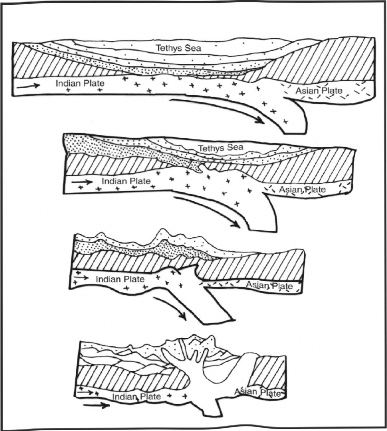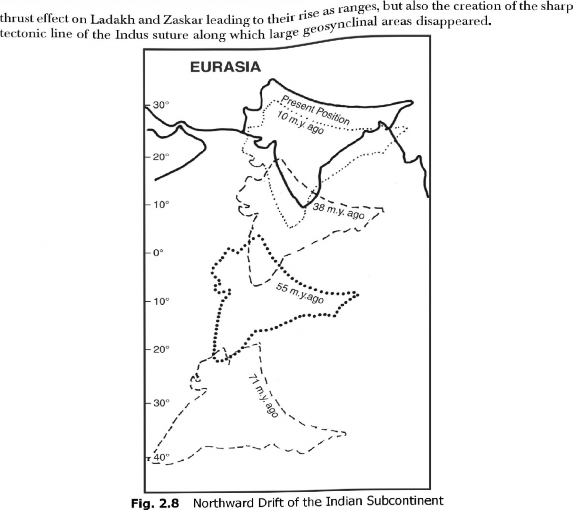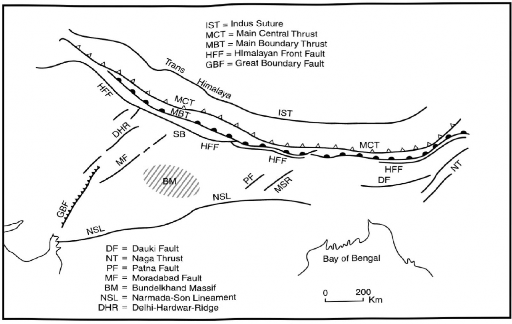(ii) The Plate Tectonic Origin of the Himalayas
The theory of Plate Tectonics was put forward by WJ. Morgan of Princeton University in 1967. This theory is based on the concept of‘Sea-Floor Spreading’ advocated by II.H. Hess. According to this theory, about 70 or 65 million years ago there was an extensive geosyncline, called the Tethys, in place of the Himalayas. About 65-30 million years ago the Indian plate came very close to the Asian plate and started subducting under the Asian plate (Fig. 2.6). This caused lateral compression due to which the sediments of the Tethys were squeezed and folded into three parallel ranges of the Himalayas. It has been estimated that this convergence has caused a crustal shortening of about 500 km in the Himalayan region and is compensated by sea floor spreading along the oceanic ridge in the Indian ocean region. Since the northward movement of the Indian plate is still continuing, the height of the Himalayan peaks is increasing. The Indian Plate is moving

Fig. 2.6 Plate Tectonics and Origin of the Himalayas

The continent-to-continent collision between the Indian and the Asiatic plates started around 65 million years ago and caused the Himalayas to rise from the Tethys geosyncline. Thus, the first major phase of uplift in the Himalayas occurred ar ound 65 million years ago. This orgenic movement elevated the central axis of ancient crystalline and meta-sedimentary rocks winch have been intruded by large masses of granite. It is believed that the first major phase of uplift initially produced the Ladakh and Zaskar ranges of the Trans-Himalayas before the formation of the Great Himalayas. Hence, it is to be realized that except the Kashmir part of the Himalayas, the Himalayan ranges have not developed from a geosyncline and are made up of elements formerly connected to the marginal parts of the Indian shield. During the main Himalayan orogeny, this continuous geosynclinal sedimentation led to the underthrusting of the Indian shield against the Tibetan Massif which buckled down the geosynclinal deposits, resulting in the outflow of a large amount of ultrabasic rocks known as ophiolites. These ophiolites are seen as exotic blocks on the Ladakh and Zaskar Ranges of the Trans-IIimalayas. The end effect of the buckling of the geosyncline was not only the crustaline

The intermontane basins in the Indus suture zone of Ladakh continued to receive molasses sedimentation in this period. The second major uplift which took place around 45 million years ago, caused the rapid uplift of the southern mountain front of the Lesser Himalayas, giving rise to the extremely rugged and youthful Pir-Panjal, Dhauladhar, Karol, and Mahabharat Ranges abruptly and steeply. The Greater Himalayas and the Lesser Himalayas are separated by the Main Central Thrust (MOT). These spurs of the Lesser Himalayas again formed, in their turn, the intermontane basins of Kashmir, the Karol-basin, Dun Valley (Uttarakhand) and the Kathmandu Valley of Nepal. The foredeep which was formed further away received the thick sequence of terrestrial sediments called Shiwaliks from the middle-Miocene to the middle-Pleistocene periods, covering a span of about 1.4 million years. The Lesser Himalayas and the Shiwaliks are separated from each other by the Main Boundary Thrust (MBT). The 5000 metres thick Shiwaliks dominated by boulder

Fig. 2.9 Major Faults of the Himalayas
and conglomerate, reflect the progressive uplift of the Himalayas from which they have been derived as a result of the third major phase of uplift. The Shiwaliks are separated from the Northern Plains of India by the Himalayan Front Fault or IIFF (Fig. 2.9 and Fig. 2.10).
The Shiwaliks form the normal Jura type of structures with wider basin-like synclines alternating with steep, often faulted, asymmetric anticlines. At present, the Himalayan Front Fault (HFF) is quite active recording frequent tremors and earthquakes .
